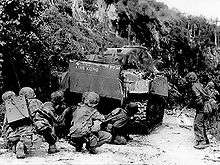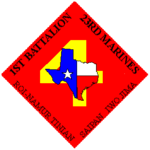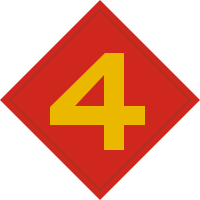1st Battalion 23rd Marines
| 1st Battalion, 23rd Marines | |
|---|---|
|
1st Battalion, 23rd Marines insignia | |
| Active | Early 1940s |
| Country | United States |
| Branch | USMC |
| Type | Infantry Battalion |
| Role | Locate, close with and destroy the enemy with fire and maneuver |
| Size | 1000 |
| Part of |
23rd Marine Regiment 4th Marine Division |
| Garrison/HQ | Houston, Texas |
| Nickname(s) | "Lone Star" |
| Anniversaries | November 10, 1775 Birthday of the Marine Corps |
| Engagements |
World War II * Battle of Kwajalein * Battle of Tinian * Battle of Saipan * Battle of Iwo Jima Gulf War *Operation Desert Storm War on Terror *Operation Iraqi Freedom |
| Commanders | |
| Current commander | LtCol John Cowert |
1st Battalion, 23rd Marines (1/23) is one of 36 infantry battalions in the United States Marine Corps, and one of only nine battalions found in the reserve. It is located throughout Texas and Louisiana consisting of approximately 1000 Marines and Sailors. They fall under the command of the 23rd Marine Regiment and the 4th Marine Division.
Current units
| Name | Location |
|---|---|
| Headquarters and Services Company | Houston, Texas |
| Alpha Company | Houston, Texas |
| Bravo Company | Bossier City, Louisiana |
| Charlie Company | Corpus Christi, Texas |
| Charlie Company(Det) | Harlingen, Texas |
| Weapons Company | Austin, Texas |
Mission
Provide trained combat and combat support personnel, and units to augment and reinforce the active component in time of war, national emergency, and at other times as national security requires; and have the capability to reconstitute the Division, if required.
History
World War II
The battalion was activated on November 20, 1942 at Marine Corps Base Camp Pendleton, California.
They participated in the Battle of Kwajalein (Roi and Namur) where they landed as part of the initial assault on 31 January 1944. Their assault objectives were the heavily defended Japanese occupied twin islands of Roi-Namur in the Kwajalein Atoll of the Marshall Islands in the Central Pacific. Roi-Namur were two tiny islands in the northern part of the atoll. It was the site of major Japanese three-runway airbase. 23rd Marines attacked Roi while the 24th Marines landed on Namur. The regiment secured Roi by the evening.

Their next action came during the Battle of Saipan which began on 15 June 1944. The island of Saipan was the linchpin in the Japanese defense of the Central Pacific. To make an amphibious assault even more difficult, Saipan also had several towns and a civilian population of about 20,000. Using the lessons learned at Roi-Namur, intensive pre-invasion naval bombardments and air strikes on Japanese positions began on 11 June 1944. Marines came ashore and were immediately met with intense and accurate fire from Japanese mortars, howitzers and antiboat guns. By 17 June 1944 a beachhead had been secured and on 18 June the Marines captured Aslito Airfield cutting Japanese defenses in two. The forces had to fight back a fierce Japanese counterattack in the form of banzai charges. The 4th Marine Division completed mopping up on Saipan on 16 July 1944 leaving only a week for preparation for the invasion of Tinian.
The Invasion of Tinian commenced on 25 July 1944. The 4th Marine Division was selected to lead the assault on Tinian. Again, the pre-invasion bombardment built to a crescendo as H-hour approached. Assault elements met only limited small arms fire when they reached the beach. With nightfall, came the expected Japanese counterattacks. The division employed flame throwers, demolition charges and automatic weapons fire to route Japanese soldiers out of caves, bunkers, and other defensive positions on the southern portion of the island. One of the most difficult aspects of the final phase of battle was convincing Japanese soldiers and thousands of civilians to surrender.

The final combat action for 1/23 would come during the Battle of Iwo Jima. Iwo Jima was only 750 miles from Tokyo and was a major objective on the way to the Japanese mainland. The Japanese were painfully aware of the strategic importance of Iwo Jima and had prepared extensive and formidable defenses with a network of miles of underground caves and tunnels. The tunnels were in the islands black volcanic rocky base well protected from preinvasion naval and air bombardment. The 4th Marine Division landed in the first assault wave on 19 February 1945 . The 23rd and 24th Marine Regiments led the division’s assault. The 23rd Marines were ordered to seize the Motoyama Airfield. High seas, heavy surf and loose volcanic soil made movement off the beaches difficult. By 20 February 1945, 23rd Marines had made good progress towards capturing the airfield. With the exception of a few remaining small pockets of resistance, the division had defeated the resolute and entrenched enemy in its zone of action in twenty days at a cost of nearly 50 percent combat efficiency.
Gulf War
The battalion was mobilized for the first time since World War II in January 1991 in support of Operation Desert Shield. The unit was deployed to Marine Corps Base Camp Pendleton, California in support of the 1st Marine Division during this time.
Global War on Terror
Operation Enduring Freedom(January 2002-January 2003) Elements of the battalion were activated after the September 11th attacks. Bravo Company and attachments from Alpha Company's Weapons platoon were deployed to Guantanamo Bay, Cuba, where they provided perimeter security for the base.
Operation Iraqi Freedom (June 2004) The battalion was again mobilized in June 2004 to conduct three months of pre-deployment training at the Marine Corps Air Ground Combat Center Twentynine Palms, California in preparation for their upcoming deployment in support of Operation Iraqi Freedom. The battalion arrived in Iraq, relieving 2nd Battalion, 7th Marines in late August 2004. They augmented the 7th Marine Regiment, helping to secure the area spanning the Hit-Haditha corridor, west of Ramadi, out to the Syrian border of the Al Anbar Province. Initial assignments for the battalion's companies in Iraq saw assignments in Ar-Rutbah, Al Asad Airbase and Hit. The battalion returned from Iraq in late March 2005, having been relieved by 3rd Battalion, 25th Marines.

In May 2007, Marines that had not participated in the June 2004 mobilization were tasked to support 3rd Battalion, 23rd Marines in their upcoming activation. Volunteers from the first mobilization were also part of this support. These Marines were deployed back to the Al Anbar Province and conducted operations near and around the Haditha Dam.
Operation Enduring Freedom (Afghanistan)
The Marines from 1/23 have just returned to the United States after 7 months in Afghanistan in support of OEF.
Medal of Honor Recipients
Joseph William Ozbourn, USMCR, Co B, 1st Battalion, 23d Marines, 4th Marine Division, 30 July 1944, Tinian Island, Mariana Islands
Darrell Samuel Cole, USMCR, Co B, 1st Battalion, 23d Marines, 4th Marine Division, 19 February 1945, Iwo Jima
Unit awards
A unit citation or commendation is an award bestowed upon an organization for the action cited. Members of the unit who participated in said actions are allowed to wear on their uniforms the awarded unit citation. 1/23 has been presented with the following awards:
| Ribbon | Unit Award |
| Presidential Unit Citation | |
| American Defense Service Medal with one Bronze Star | |
| Asiatic-Pacific Campaign Medal with four Bronze Stars | |
| World War II Victory Medal | |
| National Defense Service Medal with three Bronze Stars | |
| Iraq Campaign Medal | |
| Global War on Terrorism Expeditionary Medal | |
| Global War on Terrorism Service Medal |
See also
| Wikimedia Commons has media related to 1st Battalion 23rd Marines. |
Navy Unit Commendation Afghanistan Campaign Medal
References
 This article incorporates public domain material from websites or documents of the United States Marine Corps.
This article incorporates public domain material from websites or documents of the United States Marine Corps.
- Bibliography
- Rottman, Gordon L. (2002). U.S. Marine Corps World War II Order of Battle - Ground and Air Units in the Pacific War, 1939–1945s. Greenwood Press. ISBN 0-313-31906-5.
- Web
- 1/23's Official Website
- 1/23 Parent's website
- Charle Co 1/23 World War II veterans site
- 1/23 Landing in Tinian World War II 1944
- Opinion of 1/23 by Major High in Iraq Dec 25, 2004
- 1/23 Provides Security for Iraqi Elections 2005
- Bravo Co 1/23 in the Fight in Iraq 2005
- 1/23 Sniper Confirmed with Longest Shot 2005
- 1st Battalion 23d Marines Ceremony in Iraq 2005
- Texas Welcomes Home 1/23 in 2005
- Texas Governor Press Release on 1/23 2005
- Politics1.com 1/23 blog by Lt. Crabtree
- Bravo Co 1/23 I-I Gazette Article on Leadership Mentoring 2007 (Archived 2009-07-22)
- 58 Weapons Marines from 1/23 Welcomed Home from Iraq 2008
- Weapons Co 1/23 Live Fire in Hawthorne, NV 2009 (Archived 2009-07-22)


